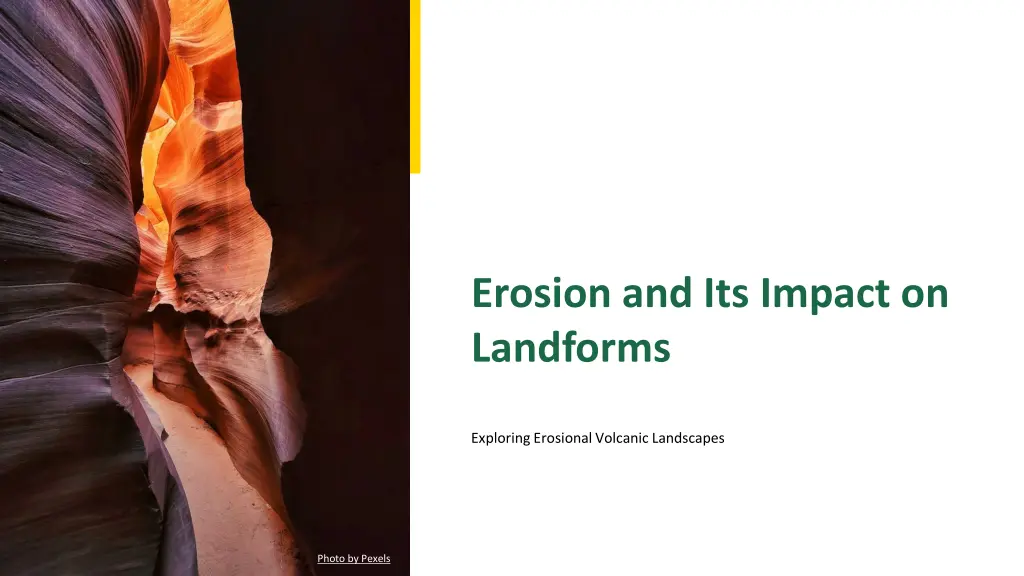
Exploring the Impact of Erosion on Landforms
Discover the fascinating world of erosional volcanic landscapes, where natural forces like water, wind, and ice shape the Earth's terrain over time. Volcanoes, nature's giants, create unique landforms that reflect the ongoing interaction between volcanic activity and erosion. Explore the never-ending cycle of erosion that reshapes our planet's surface, influencing ecosystems and human activities. Learn how erosion impacts ecosystems, highlighting the delicate balance between geological processes and environmental conservation efforts.
Download Presentation

Please find below an Image/Link to download the presentation.
The content on the website is provided AS IS for your information and personal use only. It may not be sold, licensed, or shared on other websites without obtaining consent from the author. If you encounter any issues during the download, it is possible that the publisher has removed the file from their server.
You are allowed to download the files provided on this website for personal or commercial use, subject to the condition that they are used lawfully. All files are the property of their respective owners.
The content on the website is provided AS IS for your information and personal use only. It may not be sold, licensed, or shared on other websites without obtaining consent from the author.
E N D
Presentation Transcript
Erosion and Its Impact on Landforms Exploring Erosional Volcanic Landscapes Photo by Pexels
01 Understanding Erosion Table of Contents 02 The Erosional Forces 03 Volcanoes: Nature's Giants 04 The Cycle of Erosion 05 Impact on Ecosystems 06 Human Influence 07 Conservation Strategies 08 Thank You!
1 Understanding Erosion The Power of Nature Erosion is a natural process that shapes landscapes, affecting soil, rock, and landforms over time. It plays a pivotal role in defining our planet's terrain by wearing away surfaces throughwind, water, and ice. Understanding erosion helps us appreciate the delicate balance between geological processes and land formation. Erosion also influences ecosystems, climate, and human activities, highlighting its significance in environmental studies. Photo by Pexels
2 The Erosional Forces Natural Agents at Work Weathering and erosion work hand in hand, with water, wind, and ice acting as the primary agents of change. Water can erode through rivers, rainfall, and ocean waves, carving the land into various shapes and forms. Wind erodes landscapes in arid regions, moving dust and sand to create dunes and shaped rock formations. Ice, particularly glaciers, sculpts valleys and mountain ranges, leaving behind striking evidence of its erosive power. Photo by Pexels
3 Volcanoes: Nature's Giants Erosional Volcanic Landforms Volcanoes are fascinating geological features formed by the movement of molten rock from beneaththe Earth s crust. Erosional volcanic landforms emerge when volcanic materials are subjected to weathering and erosion over time. These landscapes showcase unique formations like volcanic plugs, calderas, and ash conical hills. Understanding these features reveals the history of volcanic activity and its ongoing interaction with erosional processes. Photo by Pexels
4 The Cycle of Erosion A Never-Ending Story Erosion is a continuous process that reshapes landforms, influencing their lifecycle from creation to destruction. Over time, volcanic landscapes evolve, revealing the intricate relationships between geology and surface processes. Every phase of erosion contributes to the dynamic nature of Earth s surface, providing insights into geological history. This cyclical process highlights the importance of conservation efforts to protect these fragile environments. Photo by Pexels
5 Impact on Ecosystems Life Amidst Change Erosion affects not only the landforms but also the ecosystems that dependon them for survival and growth. The loss of soil and vegetation can lead to habitat destruction, threatening biodiversity and ecological balance. Conversely, erosion can create new habitats, allowing species to thrive in altered landscapes. Understanding these relationships is crucial for environmental management and conservation strategies. Photo by Pexels
6 Human Influence A Double-Edged Sword Human activities can exacerbate erosion, especially through deforestation, agriculture, and land development. Urbanization leads to increased runoff, which accelerates the erosion process and alters natural landforms. Conversely, responsible management can mitigate erosion, preserving vital resources and landscapes. Awareness and education on sustainable practices are essential for futureland preservation and ecological health. Photo by Pexels
7 Conservation Strategies Protecting Our Earth To combat erosion, various conservation techniques can be employed, including reforestation and soil management. Building barriers, using cover crops, and creating terraced landscapes are effective erosion control measures. Engaging communities in conservation efforts fosters a collective responsibility towards preserving our planet. Investing in education and research can enhance our understanding of erosion and its impacts, leading to better strategies. Photo by Pexels
8 Thank You! Your Attention Matters Thank you for exploring the dynamic relationship between erosion and volcanic landforms with us today! Erosion shapes not only our landscapes but also our understanding of natural processes and ecosystems. Let s work together towards a sustainable approach for preserving our precious Earth. Photo by Pexels
